78 Worked Examples: Airfoils & Wings
Many of these worked examples have been fielded as homework problems or exam questions.
Worked Example #1
The diagram below shows pressure distribution on an airfoil at 10 angle of attack. The questions involve answers and annotations.
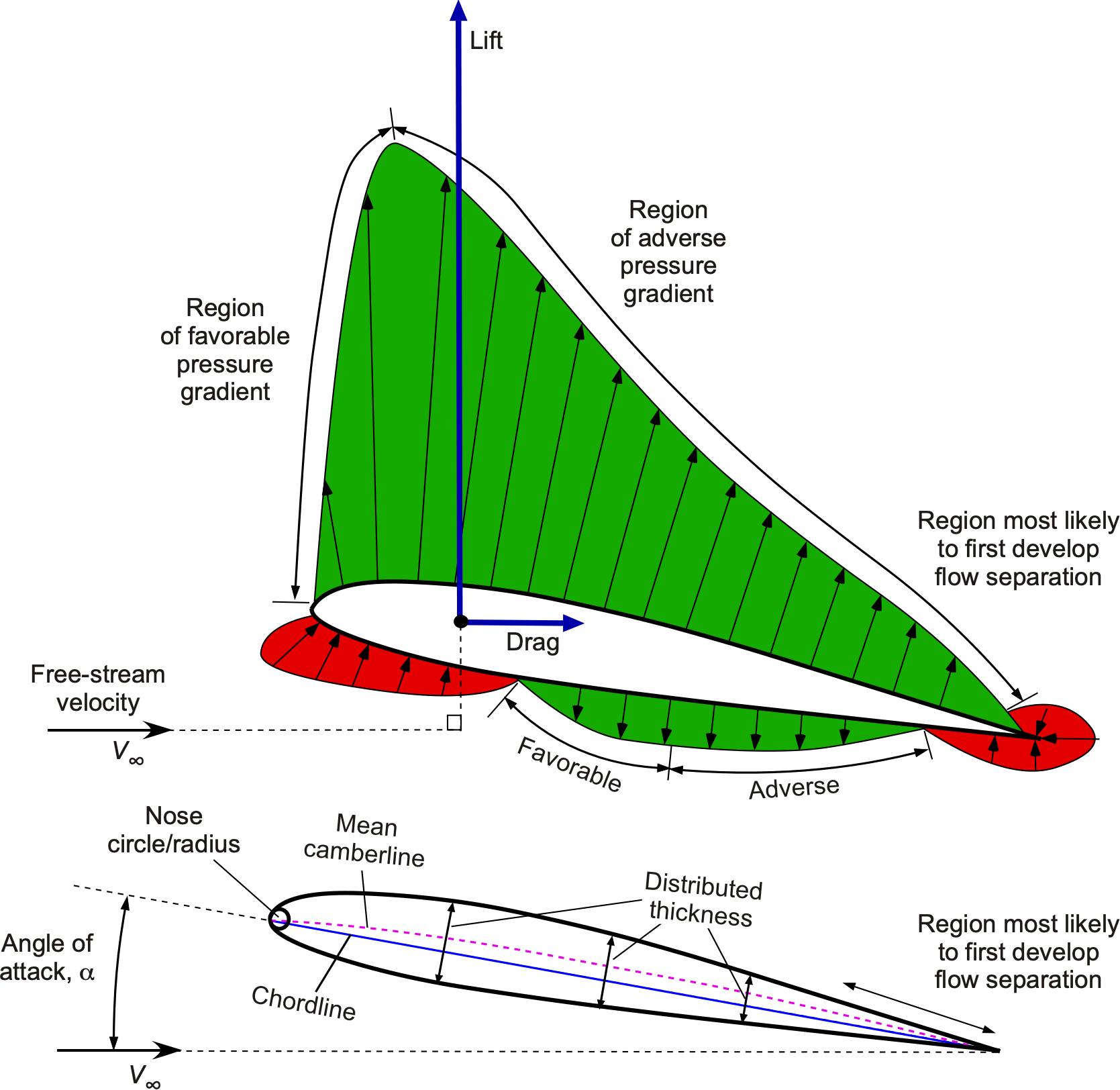
- Use a solid line to indicate the chord line of the airfoil and a dashed line to indicate the mean camberline. See the figure.
- Indicate the thickness distribution of the airfoil. See the figure.
- Using the NACA method of airfoil construction, the thickness distribution is then plotted perpendicular to the mean camberline.
- Indicate the nose radius and explain why a nose radius is used on an airfoil. See the figure. The nose radius gives a smooth, geometrically defined nose shape.
- Explain why an airfoil section is designed with a finite thickness at its trailing edge. For manufacturing reasons.
- Indicate the angle of attack and explain why this airfoil will have a non-zero angle of attack. See the figure. The airfoil has a positive mean camberline, so the angle of attack must be depressed to a negative value to create zero lift.
- Indicate the lift and drag vectors acting on the airfoil. See the figure.
- If
and
per
, then calculate the lift coefficient. The lift coefficient is
- Indicate at least one region with a favorable pressure gradient and one with an adverse pressure gradient on this airfoil. See the figure.
- At the designated angle of attack, which region of the airfoil would be more likely to experience flow separation? Explain. See the figure. The adverse pressure gradient is significant on the upper surface near the trailing edge.
Worked Example #2
Consider the following equations for the lift and drag
forces acting on an airfoil as functions of the normal force
, the axial force
, and the angle of attack
, i.e.,
Using these equations, derive expressions for and
in terms of
,
, and
.
To find and
, we start with the given equations, i.e.,
Multiply the first equation by and the second by
, giving
Adding these equations gives
Using the identity gives
Now, multiply the first equation by and the second by
giving
Subtracting these equations gives
Using , then
Therefore,
Worked Example #3
Assuming a lift-curve slope for the linear range is 0.11 per degree angle of attack, i.e., per deg., then calculate the lift coefficients at 2, 6, and 10 deg. angle of attack for (a) A symmetric airfoil; (b) A positively cambered airfoil with a zero lift angle of attack of -1.2 deg; (c) A reflexed airfoil with a zero lift angle of attack of 1.7 deg.
(a) The equation for the lift coefficient in the linear range is given by
In this case, .
For 2, then
= 0.22
For 6, then
= 0.66
For 10, then
= 1.1
(b)
For 2, then
= 0.352
For 6, then
= 0.792
For 10, then
= 1.232
(c)
For 2, then
= 0.033
For 6, then
= 0.473
For 10, then
= 0.913
Worked Example #4
Given that the pressure coefficient distribution over a 2-dimensional body of chord
is described by
on the upper surface of the body and
on the lower surface of the body, then calculate (by integration): (a) The lift coefficient acting on the body; (b) The pitching moment coefficient on the body about its leading edge.
The pressure distribution in this question is given in analytic form, allowing for the solution of the problem without any numerical integration. However, a MATLAB code is provided to check this answer using numerical integration.
(a) The lift coefficient is given by
In this case we can see that so the integral for
becomes
(b) The pitching moment about the leading edge is
Substituting then
Here is some MATLAB code to cross-check the results and plot the pressure distribution.
clc
figure
axis([0.0 1.0 1.0 5.0])
x = linspace(0.0,1.0,100); %set the range of x/c values
cpu = -4.*(1-x);
cpl = 1.*(1-x);
dcp = cpl-cpu;
trapz(x,dcp) % check to find the section cl using the trapezoidal rule
dcpx = -dcp.*x;
trapz(x,dcpx) % check to find the section cl_le using the trapezoidal rule
plot(x,-cpu);hold on
plot(x,-cpl)
xlabel(‘x/c’)
ylabel(‘-C_P’)
legend(‘Upper surface’, ‘Lower surface’)
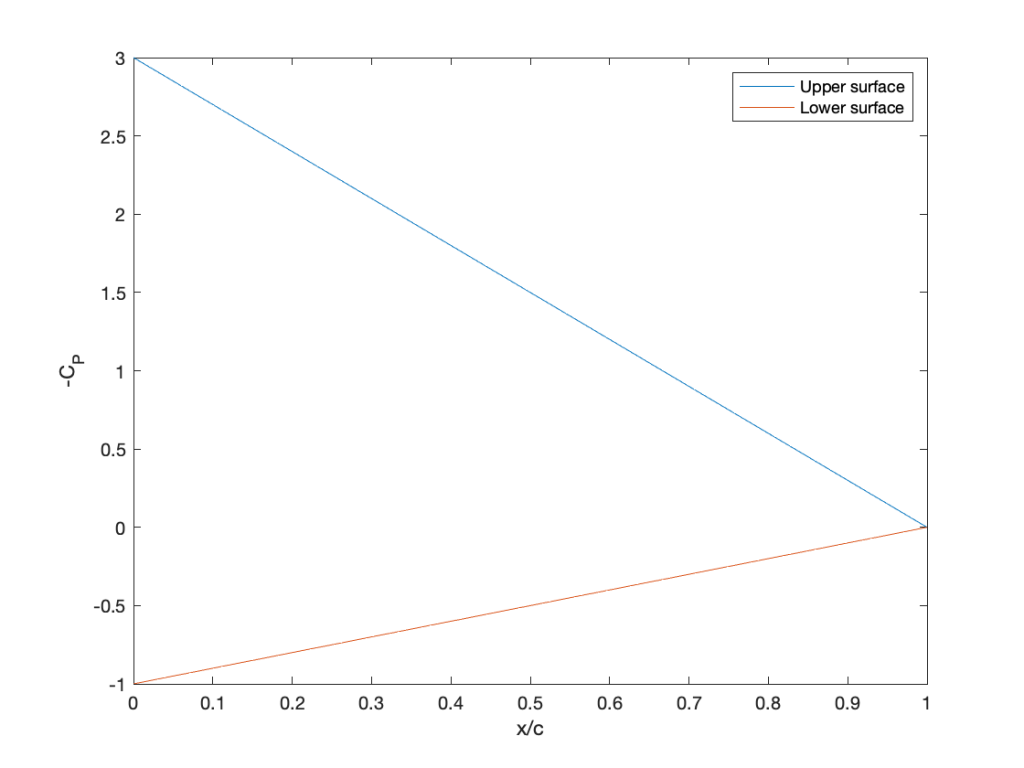
Worked Example #5
The pressure coefficient distribution over a 2-dimensional body of chord
operating at a low angle of attack is described by
(a) Use MATLAB to plot the pressure coefficient distribution. (b) Calculate the lift coefficient by analytic integration. (c) Calculate the lift coefficient in MATLAB by numerical integration.
(a) The pressure distribution looks like this (see the last part of the answer for the code):

which, for this problem, we can split into two integrals, namely
Taking the first integral gives
and so
Taking the second integral gives
and so
Therefore,
(c) The MATLAB code, which uses numerical integration, gives = 1.4025, so the results of the two methods agree.
clc
figure
axis([0.0 1.0 1.0 5.0])
x1 = linspace(0,0.1,500);
x2 = linspace(0.1,1,500);
cpu_1 = 1.-300*x1.^2;
cpu_2 = -2.2277 + 2.2777.*x2;
x = [x1 x2];
cpu = [cpu_1 cpu_2];
cpl = (1.0-0.95*x);
dcp = cpl-cpu;
trapz(x,dcp) % section cl using the trapezoidal rule
plot(x,cpu);hold on
plot(x,cpl)
xlabel(‘x/c’)
ylabel(‘C_P’)
legend(‘Upper surface’, ‘Lower surface’)
Worked Example #6
As shown in the table below, the lift, drag, and pitching moment coefficient measurements for a NACA 2412 airfoil will be used to calculate specific derived aerodynamic quantities. First, determine the values of the following parameters: (a) Lift curve slope; (b) Zero-lift angle of attack; (c) Drag polar (as a plot); (d) The best lift-to-drag ratio; (e) Center of pressure location (as a plot).
| -2 | 0.05 | 0.006 | -0.042 |
| 0 | 0.25 | 0.006 | -0.040 |
| 2 | 0.44 | 0.006 | -0.038 |
| 4 | 0.64 | 0.007 | -0.036 |
| 6 | 0.85 | 0.0075 | -0.036 |
| 8 | 1.08 | 0.0092 | -0.036 |
| 10 | 1.26 | 0.0115 | -0.034 |
| 12 | 1.43 | 0.015 | -0.030 |
| 14 | 1.56 | 0.0186 | -0.025 |
(a) Lift curve slope = =
= 0.0949 per degree, as shown on plot below. The slope is obtained using a least-squares linear fit.
(b) Zero-lift angle of attack = = -2.75 degrees, as shown on the same plot.

(c) Drag polar (as a plot), as per the plot shown below
(d) The best lift-to-drag ratio = , which is about 115 in this case and not untypical for a two-dimensional airfoil.
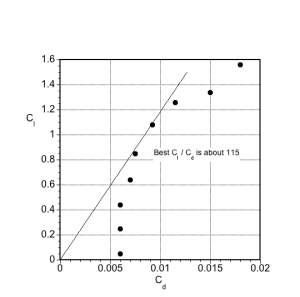
(e) Center of pressure location, as shown in the plot below.
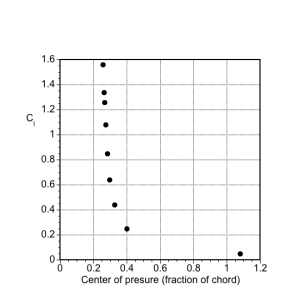
Worked Example #7
Examine the attached graph, which shows the aerodynamic coefficients for a NACA 66-212 airfoil section.
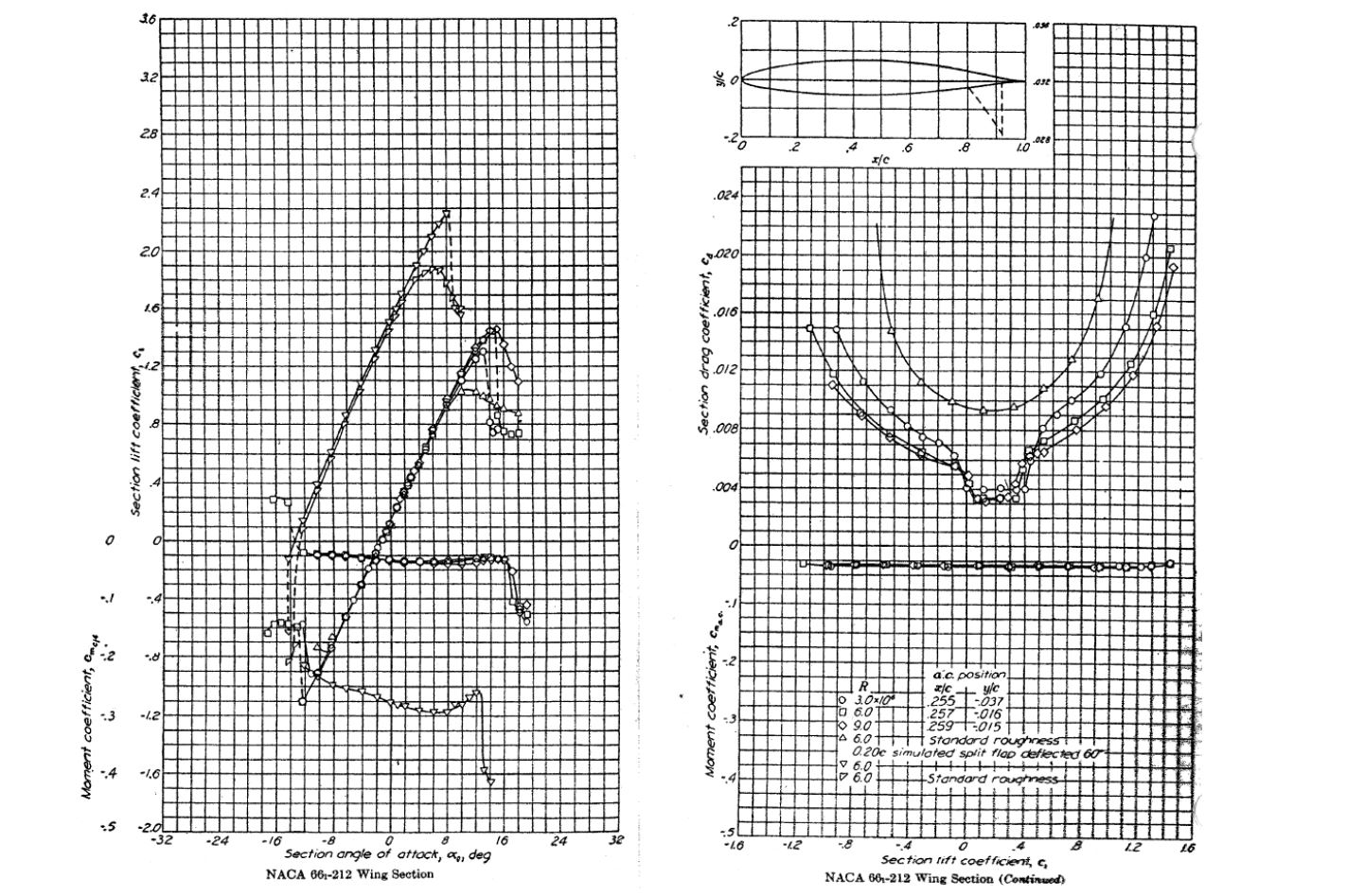 For the flap-up case, then, estimate the following values for a Reynolds number of
For the flap-up case, then, estimate the following values for a Reynolds number of (you may also want to annotate the graph):
(a) The zero-lift angle of attack.
(b) The maximum lift coefficient.
(c) The stall angle of attack.
(d) The minimum drag coefficient. Also, why is there a “bucket” in the drag curve?
(e) The lift-to-drag ratio at an angle of attack of 8 degrees.
(f) The minimum drag coefficient with roughness. Explain why the drag of the airfoil increases with the application of roughness.
(a) The zero-lift angle of attack. Answer: -1.5.
(b) The maximum lift coefficient. Answer: 1.45.
(c) The stall angle of attack. Answer: 15
(d) The minimum drag coefficient. Answer: 0.003. There is a “bucket” in the drag curve because this airfoil experiences extended regions of laminar boundary layer flow between certain (low) angles of attack. Such characteristics are typical of certain airfoil sections, especially those used on sailplanes.
(e) The lift-to-drag ratio at an angle of attack of 8 degrees. Answer: 92
(f) The minimum drag coefficient with roughness. Answer: About 0.009. Surface roughness disrupts the laminar boundary layer over the front part of the airfoil, causing it to transition to turbulence, which in turn increases skin friction drag. You can think of roughness as equivalent to using some medium-grade sandpaper on the surface. Airfoils and wings for airplanes are often tested in the wind tunnel with smooth and rough surfaces, the idea being to simulate the effects of wear and tear on the wing after the airplane has been in operational service. Some airfoils, such as the one shown in this example, are particularly sensitive to the effects of surface roughness.
Worked Example #8
Modify the MATLAB NACA 230-series camberline airfoil generator code given in the eBook to plot some of the NACA 231 series reflexed airfoils. Why is reflex camber used on an airfoil? You should plot the NACA 23112 and NACA 23118 shapes, but you may plot different shapes in the series if you wish.
The camberline for the NACA 3-digit 231-series reflex airfoils is given by
and
where ,
,
, and
.
The MATLAB code below will draw a NACA 231-series reflexed airfoil. Remember that the reflex camber aims to reduce the pitching moment on the airfoil.
t = 0.12;
m = 0.217; %location of maximum camber
k1 = 15.793; %constant
k2k1 = 0.006770;
r = 1.1019.*(t^2); %radius of leading edge circle
x1 = linspace(r/3,m,round(m.*500)); %x coordinates nose circle to m
x2 = linspace(m,1,round((1-m).*500)); %x coordinates m to 1
y_cam_1 = (k1./6).*(((x1-m).^3)-k2k1*((1-m).^3)*x1-(m.^3)*x1+m.^3); %camber line y coord 0 to m
y_cam_2 = (k1./6).*((k2k1*(x2-m).^3)-((k2k1*(1-m).^3)*x2)-((m.^3)*x2)+(m.^3)); %camber line y coord m to 1
x = [x1 x2]; %merged x coordinates
y_cam = [y_cam_1 y_cam_2]; %merged y camber coordinates
dy_cam_1 = (k1./6).*((3.*(x1-m).^2)-k2k1*(1-m).^3-(m.^3)); %derivative of camber line 0 to m
dy_cam_2 = (k1./6).*((3.*k2k1*(x2-m).^2)-k2k1.*(1-m).^3-m.^3).*ones(1,length(x2)); %derivative of camber line m to 1
dy_cam = [dy_cam_1 dy_cam_2]; %merged derivative of camber line
theta = atan(dy_cam); %slope of camber line
y_t = 5.*t.*((0.29690.*sqrt(x))-(0.12600.*x)-(0.35160.*(x.^2)) +(0.28430.*(x.^3))-(0.10150.*(x.^4))); %thickness equation
x_upper = x-(y_t.*sin(theta)); %x coordinates of upper surface
x_lower = x+(y_t.*sin(theta)); %x coordinates of lower surface
y_upper = y_cam+(y_t.*cos(theta)); %y coordinates of upper surface
y_lower = y_cam-(y_t.*cos(theta)); %y coordinates of lower surface
%end points to close off trailing edge
x_end_up = x_upper(end);
x_end_low = x_lower(end);
y_end_up = y_upper(end);
y_end_low = y_lower(end);
dy_cam_005 = (1./6).*k1.*(3.*(0.005-m).^2)-k2k1*((1-m).^3-(m.^3));
%derivative of camber line at x = 0.005theta_005 = atan(dy_cam_005); %slope of camber line at x = 0.005
The shapes of the NACA 23112 and NACA 23118 are shown below.
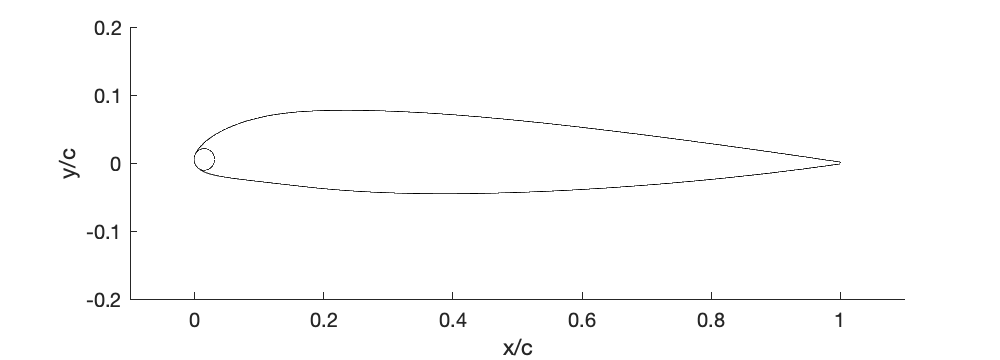
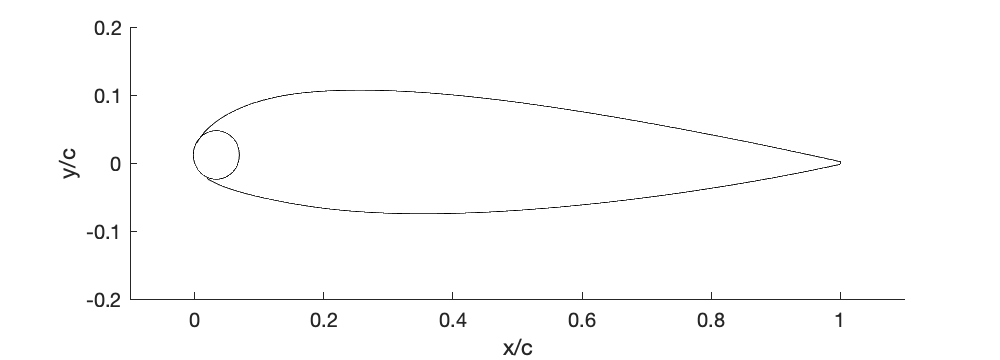
Worked Example #9
Lift, drag, and pitching moment measurements for a NACA 0012 airfoil are given in the table below. They will be used to calculate specific derived aerodynamic quantities for further analysis. As part of the analysis, you are asked to determine the following: (a) Lift curve slope (in the attached flow regime). (b) The zero-lift angle of attack. (c) Drag polar (as a plot). (d) The best lift-to-drag ratio. (e) Center of pressure location (as a plot). (f) Aerodynamic center location.
| Angle of attack | C_l | C_d | C_m |
|---|---|---|---|
| 0 | 0 | 0.00662 | 0 |
| 1 | 0.1096 | 0.0067 | 0.0006 |
| 2 | 0.2182 | 0.00693 | 0.0013 |
| 3 | 0.3254 | 0.00736 | 0.0024 |
| 4 | 0.4309 | 0.008 | 0.0038 |
| 5 | 0.5365 | 0.00881 | 0.0054 |
| 6 | 0.6509 | 0.00976 | 0.0057 |
| 7 | 0.7743 | 0.01085 | 0.0057 |
| 8 | 0.9006 | 0.01203 | 0.0041 |
| 9 | 0.9957 | 0.01328 | 0.0046 |
| 10 | 1.0836 | 0.01466 | 0.0046 |
| 11 | 1.1729 | 0.01627 | 0.0079 |
| 12 | 1.2585 | 0.01817 | 0.0113 |
| 13 | 1.3343 | 0.02057 | 0.0157 |
| 14 | 1.3928 | 0.02328 | 0.0221 |
| 15 | 1.4322 | 0.02739 | 0.0284 |
| 16 | 1.4511 | 0.0345 | 0.0315 |
| 17 | 1.4508 | 0.04615 | 0.0287 |
| 18 | 1.4004 | 0.06732 | 0.0186 |
| 19 | 1.2739 | 0.10324 | 0.0001 |
(a) Lift curve slope (in the attached flow regime). The lift-curve slope is determined by fitting a straight line (using the least-squares method) through the measurements at a low angle of attack. In this case or
= 0.107 per degree angle of attack.
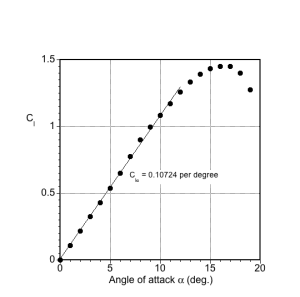
(b) Zero-lift angle of attack. This is a symmetric airfoil, so the zero-lift angle of attack is based on the linear fit and is effectively zero degrees, as expected.
(c) Drag polar (as a plot). The drag polar is a plot of the lift coefficient, , versus the drag coefficient,
. The advantage of this presentation is that a straight line running from the origin of the graph at (0,0) to any point on the polar is the lift-to-drag ratio
. The best lift-to-drag ratio is when this line is just tangent to the polar curve.

(d) The best lift-to-drag ratio. Another way to find the lift-to-drag ratio is to plot this ratio as a function of the angle of attack or
. In this case, the best lift-to-drag ratio is approximately 75, which is typical for a well-designed airfoil section.
 (e) Center of pressure location (as a plot). The center of pressure can be calculated using
(e) Center of pressure location (as a plot). The center of pressure can be calculated using
The moments are given in the data file about the 1/4-chord. The center of pressure is a function of the lift coefficient (and hence also the angle of attack), so it is not a fixed point and is not a convenient concept to use in aerodynamics. Therefore, the center of pressure is used sparingly in practice to resolve the forces and moments, even though the pitching moment is zero about this point.
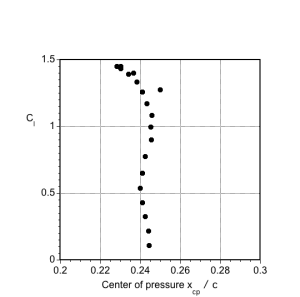
(f) Aerodynamic center location. By definition, the aerodynamic center is the point where the moment is independent of . The moments in the data file are given about the 1/4-chord (generally, this is the default), so the aerodynamic center is calculated using
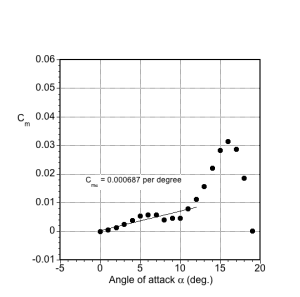
We can obtain the value of using
So, we need the lift-curve slope and the slope of the moment curve (again, in the low angle of attack regime). In this case, we have
which, unlike the center of pressure, is a fixed point. For most airfoils at low Mach numbers, the aerodynamic center is close to 1/4-chord.
Worked Example #10
An airplane wing has a semi-span of 9.5m. The wing’s root chord at the aircraft’s centerline is 1.5 m. This constant chord extends to 3 m from the root at the centerline, followed by a linearly tapered part from that point to a tip chord of 1.2 m. For this wing, calculate: (a) the wing area, (b) the aspect ratio, and (c) the mean aerodynamic chord (MAC).
(a) We can split the area calculation of each wing panel into two parts, i.e., , with the first part ending at a distance
= 3 m from the wing root and the second part running to the wing tip. For the first (rectangular) part of the wing panel, then
remembering to multiply by two because there are two wing panels. For the second (tapered) part, then
Again, the factor of 2 denotes two wing panels. Therefore, the total wing area is
(b) The aspect ratio of this wing is
(c) The MAC is given by
In this case, we have two parts to the wing panel: the first part has a constant chord and ends at a distance m from the wing root. We need to evaluate the term
The first term is easy because , so
The second term involves the tapered part of the wing, so for , the chord variation is
If we let
then
and if we let
then
Therefore, we have that
Introducing the limits of integration and evaluating all of the terms gives
and so the MAC is
Worked Example #11
A wing has an aspect ratio of 12. The chord of the wing varies smoothly and continuously outward from the centerline of the aircraft according to
For this wing, then calculate the wing span and the wing area.
The area of the wing is
The chord for this wing is
and substituting for the chord distribution gives
Introducing the limits of integration gives
noting that .
The aspect ratio of this wing is
Therefore, solving for the span for an aspect ratio of 12 gives
and so the area of this wing is
Worked Example #12
A sailplane wing has a span of 15 m. The root chord at the aircraft’s centerline is 1 m, and the wing tapers linearly from the root to the tip with a tip chord of 0.5 m. For this wing, calculate: (a) the wing area, (b) the aspect ratio, and (c) the mean aerodynamic chord (MAC).
We are given the wing’s span (distance from the left wing tip to the right wing tip) , the root chord
, and the tip chord
. The wing panel is tapered linearly, i.e., each of the left and right-wing panels of a trapezoidal shape, so the area of one wing panel will be half of the average chord times the semi-span
. Therefore, with the two wing panels, the area
is
Notice that we can also work with a general expression for the chord as a function of distance
from the wing root to the right wing tip (a distance equal to the semi-span
) will be
where is a measure of the taper. The boundary conditions are that
and
. Therefore,
Solving for gives
and so
We can check that this expression is indeed correct by substituting and
. The area of the wing
will then be
and substituting for the chord distribution gives
Therefore,
i.e., just the standard formula for the area of a trapezoid we used previously.
The aspect ratio of this wing is
The MAC is given by
In this case, then
so
Integrating gives
so
Therefore, the MAC for this wing is
Worked Example #13
A wing of a span of 30 ft has an elliptical wing planform with a root chord of 6 ft. Calculate for this wing: (a) The wing (planform) area; (b) The aspect ratio of this wing; (c) The mean aerodynamic chord (MAC).
(a) The chord, in this case for an elliptical planform shape, is
where is the root chord. The area of the wing
is
And so substituting for the chord gives
This is a standard integral, so
Therefore, the area of the elliptical wing is
(b) The aspect ratio for this wing is
(c) The MAC is given by
In this case, then
so
This means that for this elliptical wing, then
Worked Example #14
The drag coefficient of a particular airplane is described by the equation
where is the aspect ratio of the wing. Plot the drag polars for this airplane design for wing aspect ratios of 5, 10, 15, and 20. In each case, determine the best lift-to-drag ratio and the conditions under which this occurs. Assume that the maximum attainable lift coefficient of the wing is 1.7. Comment on your results.
The MATLAB code is listed below:
clc
figure
axis([0.0 0.3 0.0 2.0])
CL = linspace(0.0,1.7,100); %set the range of CL values for A\!R = 5:5:20 % set the range of AR values
CD = 0.035+1.35*CL.^2/pi/AR;
plot(CD,CL);hold on
end
legend(‘AR=5′,’AR=10′,’AR=15′,’AR=20’);
xlabel(‘C_D’)
ylabel(‘C_L’)
The plot below shows the polar plots produced by the MATLAB code. Notice the significant effects of aspect ratio on the curve. The lower aspect ratio wing always gives higher induced drag (i.e., “drag due to lift”), so the drag increases more quickly with increasing lift coefficient.
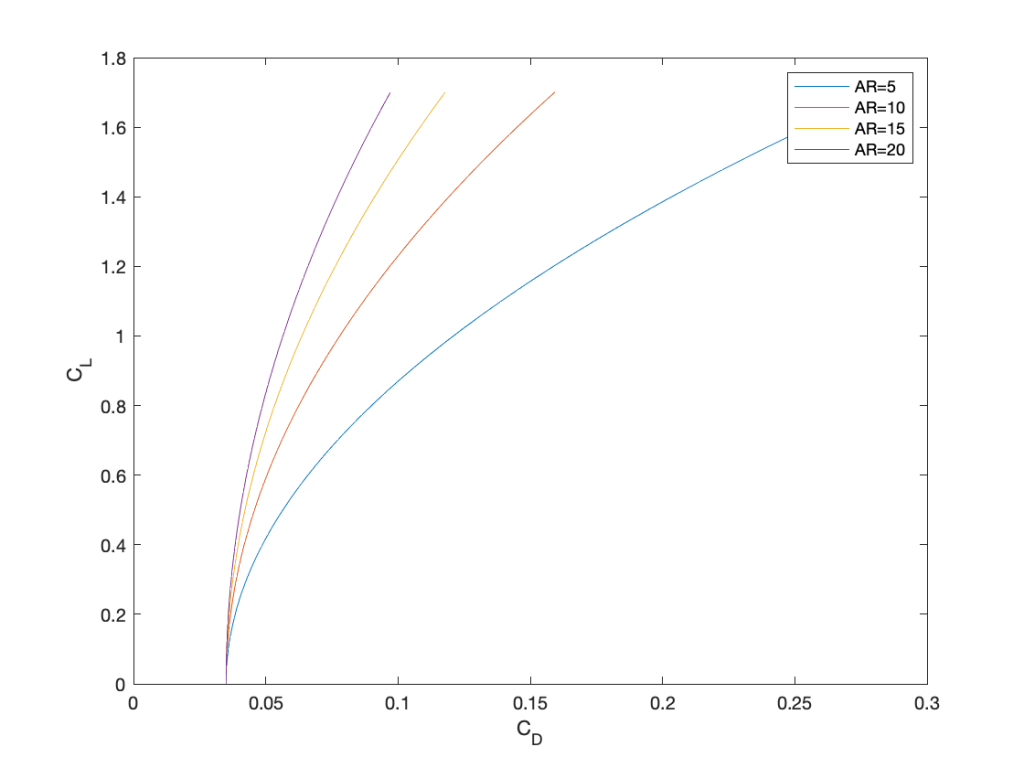
We are asked to find the best lift-to-drag ratio for each wing and the lift coefficient at which this occurs. It is possible to do that from the graph or numerically within MATLAB, but it can also be done analytically. The drag coefficient is given by
This means that
Differentiating gives
Therefore, solving for at this condition gives
This will be the lift coefficient used to obtain the maximum lift-to-drag ratio.
For then the
for best
is
The corresponding ratio is
and substituting values gives and a of 0.638 gives the best lift-to-drag ratio for this wing as
For then the
for best
is
and substituting values with = 0.903 gives the best lift-to-drag ratio for this wing as
For then the
for best
is
and substituting values with = 1.105 gives the best lift-to-drag ratio for this wing as
For then the
for best
is
and substituting values with = 1.276 gives the best lift-to-drag ratio for this wing as
The preceding results clearly show that the best lift-to-drag ratio increases with increasing aspect ratio. Also, the lift coefficient at which the best lift-to-drag ratio is obtained increases with increasing aspect ratio.
Worked Example #15
Consider a flying wing with a wing area of 210 m2, an aspect ratio of 10, and Oswald’s efficiency factor of 0.90. The airfoil section on the wing has a profile drag coefficient of 0.015. The airplane’s mass is 50,000 kg. If the aircraft is flying at a density altitude of 3 km and its true airspeed is 230 m/s, then calculate the total drag on the aircraft.
When using the ISA model, the air density at a density altitude of 3 km is 0.90925 kg m. For vertical force equilibrium, the lift on the wing
is equal to the weight of the aircraft,
, i.e.,
The lift is given by
so the operating lift coefficient of the wing is
The drag coefficient is given by
where the non-lifting part , i.e.,
.
Therefore, the drag force is
giving a lift-to-drag ratio of about 6, which seems reasonable.
Worked Example #16
Consider an aircraft with a wing with a lifting planform area 60 m
, an aspect ratio
12, and Oswald’s efficiency factor
0.90. The wing has a non-lifting profile drag coefficient of 0.01. The remainder of the aircraft has a non-lifting drag coefficient of 0.03. All force coefficients are based on wing area
. The mass of the airplane is 16,000 kg. If the aircraft is flying at a density altitude of 10,000 ft and its true airspeed is 253 kts, then calculate:
(a) The lift force produced by the wing.
(b) The lift coefficient of the wing.
(c) The drag force on the wing.
(d) The lift-to-drag ratio of the wing.
(e) The total drag force on the aircraft.
(f) The lift-to-drag ratio of the aircraft.
(a) With the assumption that the aircraft is flying along in steady, unaccelerated flight, the lift force produced by the wing will equal the weight of the aircraft, i.e.,
(b) The lift coefficient of the wing is given by
To find , we need the density of the air (in this case, at 10,000 ft) and the true airspeed in units of m/s. The density can be found from the ISA (assuming standard temperature), so
and converting from nautical miles per hour (kts) to m/s (the conversion factor is on the formula sheet) gives
Inserting the numbers gives
(c) The drag force on the wing will be given by
where is the drag coefficient of the wing, which will be given by
where the second part is the induced drag (i.e., drag due to lift). Inserting the numbers gives
Therefore, the drag force on the wing is
(d) Now that the lift and drag on the wing are known, the lift-to-drag ratio of the wing is
(e) The total drag force on the aircraft is
where is the net drag coefficient of the aircraft, which will be given by
We are given that for the remainder of the airplane, (the non-lifting part), and the second part will be from the wing (which has already been calculated). Note that all drag coefficients are defined using wing area as a reference, allowing them to be added together. For the entire aircraft, then
Therefore, the drag force on the aircraft is
(f) Now that the lift and drag are known, the lift-to-drag ratio of the entire aircraft is
Worked Example #17
As shown in the figure below, a giant flying-wing drone is cruising at an in-flight weight of 684,000 lb at a Mach number of at an altitude of 30,000 ft. The aircraft’s drag polar is given by
. The wing has a span of 235.0 feet, with a root chord of 35.0 feet and a tip chord of 12.25 feet. Assume the following ambient atmospheric conditions:
629.6 lb ft
,
F, and
0.0008903 slug ft
.

- Explain the balance of forces acting on the aircraft.
- Calculate the wing’s planform area
and aspect ratio
.
- Calculate the aircraft’s airspeed in knots and ft s
.
- Determine the operating lift coefficient
of the wing.
- Determine the aircraft’s total drag coefficient
at its current flight condition.
- What is the zero-lift drag coefficient
at these flight conditions?
- Determine the induced drag coefficient
at these flight conditions.
- Calculate Oswald’s efficiency factor
for this wing.
- Calculate the total drag force acting on the aircraft
and its lift-to-drag ratio
.
- If the TSFC of each of the four jet engines is 0.5 lb lb
hr
, approximately how much fuel will the aircraft burn in 30 minutes of flying time?
1. The aircraft is in equilibrium for steady-level flight, i.e., cruise. The sum of the forces in the vertical direction equals zero, and the sum in the longitudinal direction equals zero. This means that for vertical force equilibrium, then
and for horizontal force equilibrium
2. The wing has two trapezoidal panels, so the total wing area is given by
The corresponding aspect ratio of the wing is
3. The airspeed is
and inserting the values gives
Because 1 kt (nautical miles per hour) = 1.688 ft/s, then
4. The aircraft is cruising in steady, straight, and level flight, so and the operating lift coefficient is
5. The drag polar is given in the question as
C_D = 0.025 + 0.040 \, C_{L}^{2} = C_{D_{0}} + K \, C_{L}^{2} = C_{D_{0}} + C_{D_{i}}
\]
so = 0.025. Substituting
gives for the total drag coefficient
6. The total drag coefficient can be decomposed as
Therefore, the minimum (non-lifting) drag coefficient is
7. The induced (lifting) drag coefficient is
8. The induced drag coefficient is also given by
So, solving for Oswald’s efficiency factor gives
and using the given numerical values gives
9. The total drag is then
and inserting the numerical values gives
So, the lift-to-drag ratio is
10. The fuel flow rate is
where . Inserting the numbers gives
So, during 30 minutes of flight, the approximate weight of fuel burned is
Worked Example #18
From wind tunnel testing, a new jet airplane has been estimated to have a maximum wing lift coefficient of 3.2 when the slats are deployed and the flaps are fully extended. If the wing loading is 76.84 lb ft-2, estimate the stalling airspeed in level unaccelerated flight at a pressure altitude of 5,000 ft on a standard ISA day.
The stall airspeed can be estimated using
(1)
We are told that = 3.2 and that
= 76.84 lb ft
. We can use the ISA model at 5,000 ft on a standard day to determine that
= 0.002048 slugs ft
. Substituting gives
(2)
which is relatively low and shows the importance of getting a high value of on a wing.

